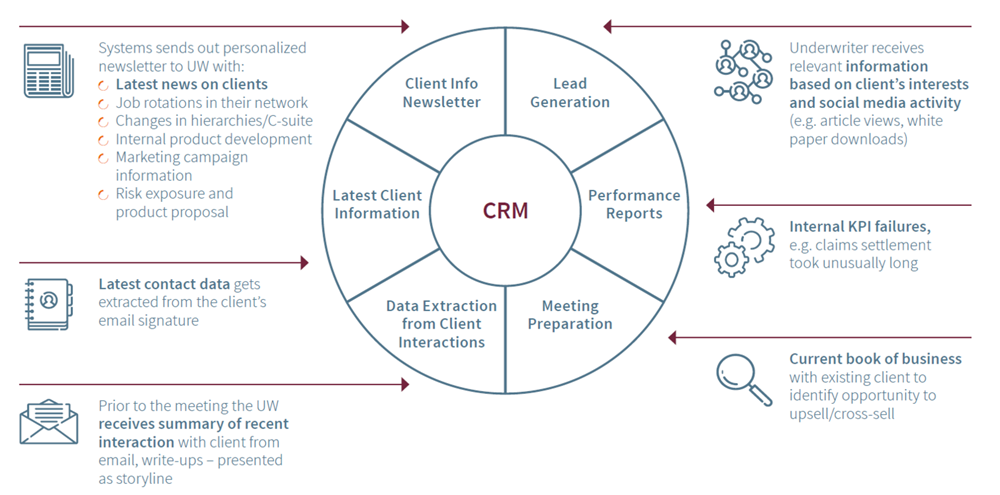For many companies, customer relationship management (CRM) implementation is just another software to manage their contacts and store customer interaction notes. We have taken a closer look at the reinsurance business to see what its CRM needs really are.
Our findings are sobering, and you might be paying for a solution that completely fails to do what you need it to do. When all is said and done, a custom CRM solution is likely to be an efficient lead-generator for your business.
If you are thinking hard about these matters, chances are that you belong to low-volume, high-value, and complex business-to-business (B2B) industry, such as reinsurance or specialty insurance. If you think hard enough, you will realise that in your business, the retail way of CRM thinking simply doesn’t work. Traditional customer relationship management solutions are built to analyse large amounts of client data and manage a sales funnel effectively.
In reinsurance and specialty insurance, you are dealing with a much smaller number of clients, with a much lower number of transactions that do, however, involve bespoke contracts characterised by the special relationship between the parties involved. It should be clear from the outset that a one-size-fits-all CRM solution is not what is required.
A reinsurance company is positioned in the market with a great network and is a trusted partner to many insurers. Whilst the commodity business rides the automation wave, the complex and high-value deals in this segment mean that automation does not make much sense.
Another factor to consider is that the reinsurance industry works on a business-to-business-to-consumer (B2B2C) model that also involves brokers in the value chain. This increases the complexity of account management in traditional CRM approaches. To get more business under this model, it’s also essential to nurture the relationship with brokers by providing them – and not only end-clients – with relevant content.
Dual role of underwriters
Before we get into how reinsurers can handle these complex relationship-based deals better, we need to identify who handles them.
In the reinsurance industry, underwriters are increasingly taking over the role of client managers. In addition to their expertise in quantitative risk analysis, underwriters are also responsible for lead generation and client life cycle management.
The advantage is that underwriters understand the end-to-end deal cycle and can put on different hats to build relationships, as well as crunching numbers to strike a deal. However, when it comes to sales management, this new class of underwriters still relies on traditional methods of information storage, such as notebooks and spreadsheets.
The fact is that the density of information has increased so much during the last decade that it is easy to miss relevant news when information is stored in spreadsheets or arrives in numerous newsletters. Even so, a good underwriter or client manager still has to address clients’ need for support and risk cover.
Traditional customer relationship management solutions are built to analyse large amounts of client data and manage a sales funnel effectively. But this isn’t relevant for reinsurers, who do not have to contend with many clients and client transactions. The key challenge in this segment is access to information. This means the reinsurance industry requires a customer information desk with a dashboard providing immediate access to relevant data, and ideally suggesting the best action for the underwriter to take next.
The customer information desk approach
A customer information desk approach starts with creating data points. Reinsurers can produce relevant data points by creating platforms, events, or communications (e.g., a new video, newsletter, article, or blog post), and then tracking who is interested in the content.
In conjunction with the annual report data and other strategic data about the client, this information is potentially very valuable for the underwriter. Given that this sort of relevant client information comes from both internal and external sources, to land the kind of high value deals it can facilitate, underwriters need all the tools at their disposal to capture and structure these data points from different pools of information.
How to build a relevant set of data points
The challenge for reinsurance companies is to build trust and make informed decisions to identify opportunities in a low-volume, high-value business. As shown in Figure 1, there are multiple ways of creating valuable data points and building scalable solutions to sustain long-term profitability.

In Figure 1, it shows that a customer-focused organisation understands the needs of their customers at the point of sale along the customer experience journey and has the right insights at hand.
Strategic decisions
Current strategic outlook of reinsurer is not the most traditional data point. However, when it comes to developing a decision support system, reinsurers can glean a lot of valuable information from their clients’ strategic decisions.
Strategic priorities, such as client retention versus new business, risk appetite, regulations, operational constraints, and company policies, provide an overview of all possible actions an underwriter can take in interactions with clients. These data points can be built into CRM workflows to align with the company’s short-term and long-term visions.
Existing data
Reinsurers can utilise existing structured and unstructured data to generate insights. This data might include summaries of recent conversations, buying patterns, the current book of business with a client, renewal dates, upcoming event or webinar invitations, historical transactions, or accepted or rejected quotes. These are the most valuable and reliable sources of information that can be used to identify deadlines, upcoming events, and opportunities to cross-sell, coupled with the right timing.
Download our full article to find additional data points!
Click below to continue reading this article and get all our insights on:
- How to identify key desicion makers
- How to leverage public information from your target client
- Which third-party sources to analyze
- How to track visitor's interest for lead generation
- How to achieve actionable insights for underwriters
- Intelligent dashboards
How Synpulse can help
At Synpulse we’ve helped reinsurers set up systems that give them a 360-degree view of their client information. We do this by providing them with a client-management-centric concept and supporting system that connect with their core underwriting workbench, policy admin system, claims management, and other administrative systems such as accounting and finance. Thanks to our understanding of the end-to-end sales and customer management life cycle within reinsurance, you get a customized solution planned and implemented precisely in line with the needs of your organization.
- How you can use existing client information in your systems to enhance your sales performance
- How to integrate intelligent dashboards with your existing systems
- How to address change management to increase adoption of these tools within your organization
- How we can help you create a targeted marketing automation workflow for your reinsurance business

